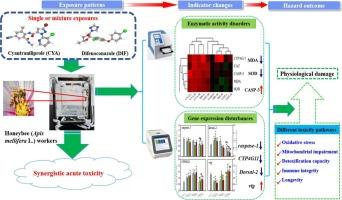协同破坏解毒,免疫,和神经通路在蜜蜂后共同暴露于氰氨酰胺和异苯康唑
IF 4
1区 农林科学
Q2 BIOCHEMISTRY & MOLECULAR BIOLOGY
引用次数: 0
摘要
二胺类杀虫剂氰虫腈(CYA)和三唑类杀菌剂二苯醚康唑(DIF)经常在蜜蜂相关基质中同时检测到。然而,这些化合物对蜜蜂(Apis mellifera L.)生理的相互作用尚未充分阐明。我们的研究结果显示,CYA和DIF共同暴露会引起明显的急性协同毒性。生化分析表明,在所有处理中丙二醛(MDA)水平、超氧化物歧化酶(SOD)和半胱天冬酶-3 (CASP-3)活性均显著升高,在共暴露条件下发生最显著的变化。这些数据表明,当两种农药同时存在时,氧化应激和线粒体损伤加剧。在转录水平上,与凋亡(caspase-1)、解毒(CYP4G11)、免疫调节(dorsal-2)和寿命调节[卵黄原蛋白(vtg)]相关的基因明显失调。值得注意的是,与单一农药处理相比,共暴露加剧了基因表达的变化,强调了一种化合物相互作用,放大了细胞的应激反应。这些发现表明,CYA和DIF,特别是两者结合,破坏了蜜蜂的关键生理途径,损害了它们的解毒能力、免疫完整性和寿命。这些见解不仅揭示了农药混合物毒性的关键机制基础,而且强调了迫切需要制定监管框架,以解决传粉媒介群体中农用化学品共同暴露所带来的混合物风险。本文章由计算机程序翻译,如有差异,请以英文原文为准。

Synergistic disruption of detoxification, immunity, and neural pathways in honeybees following co-exposure to cyantraniliprole and difenoconazole
The diamide insecticide cyantraniliprole (CYA) and the triazole fungicide difenoconazole (DIF) are frequently co-detected in bee-related matrices. However, the interactive effects of these compounds on honey bee (Apis mellifera L.) physiology remain insufficiently elucidated. Our results revealed that co-exposure to CYA and DIF elicited a pronounced acute synergistic toxicity. Biochemical assays demonstrated significant elevations in malondialdehyde (MDA) level, superoxide dismutase (SOD), and caspase-3 (CASP-3) activities across all treatments, with the most marked alterations occurring under co-exposure conditions. These data pointed to exacerbated oxidative stress and mitochondrial impairment when both pesticides were present concurrently. At the transcriptional level, notable dysregulation was observed in genes associated with apoptosis (caspase-1), detoxification (CYP4G11), immune modulation (dorsal-2), and lifespan regulation [vitellogenin (vtg)]. Notably, co-exposure intensified gene expression changes beyond those induced by single-pesticide treatments, underscoring a compound interaction that amplified cellular stress responses. These findings demonstrated that both CYA and DIF, especially in combination, disrupted critical physiological pathways in honey bees, compromising their detoxification capacity, immune integrity, and longevity. These insights not only unraveled key mechanistic underpinnings of pesticide mixture toxicity but also emphasized the urgent need for regulatory frameworks that address the mixture risks posed by agrochemical co-exposures in pollinator populations.
求助全文
通过发布文献求助,成功后即可免费获取论文全文。
去求助
来源期刊
CiteScore
7.00
自引率
8.50%
发文量
238
审稿时长
4.2 months
期刊介绍:
Pesticide Biochemistry and Physiology publishes original scientific articles pertaining to the mode of action of plant protection agents such as insecticides, fungicides, herbicides, and similar compounds, including nonlethal pest control agents, biosynthesis of pheromones, hormones, and plant resistance agents. Manuscripts may include a biochemical, physiological, or molecular study for an understanding of comparative toxicology or selective toxicity of both target and nontarget organisms. Particular interest will be given to studies on the molecular biology of pest control, toxicology, and pesticide resistance.
Research Areas Emphasized Include the Biochemistry and Physiology of:
• Comparative toxicity
• Mode of action
• Pathophysiology
• Plant growth regulators
• Resistance
• Other effects of pesticides on both parasites and hosts.

 求助内容:
求助内容: 应助结果提醒方式:
应助结果提醒方式:


